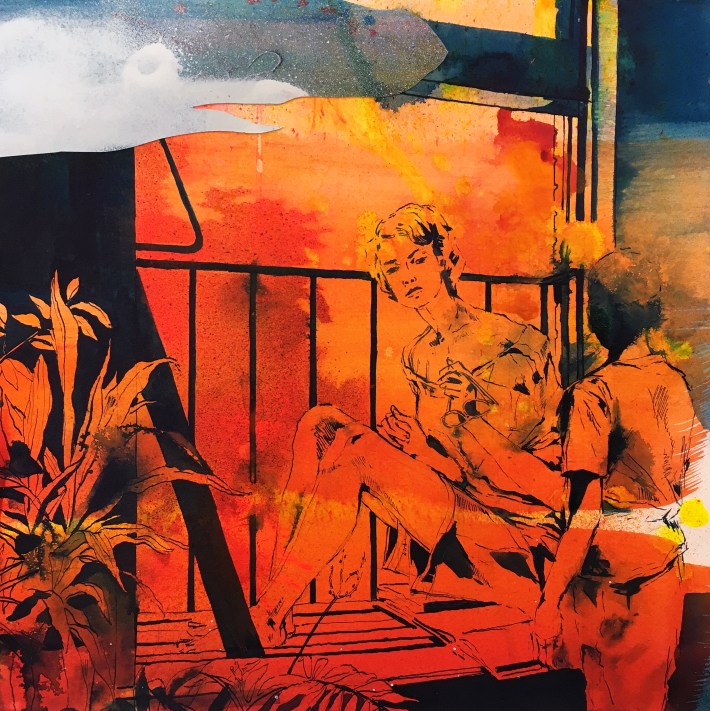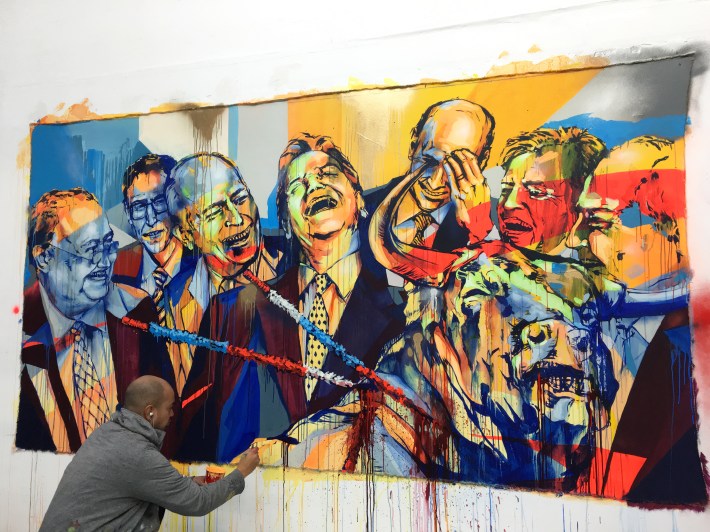Esteban delValle is a Chicago-born artist who lives in Brooklyn, has traveled the world painting murals, and has a solo show at Superchief Gallery in Downtown Los Angeles that opens this weekend. The show, Displacing Waves, explores themes that have been a constant in his work for years-- gentrification, political corruption, and the prison-industrial complex. All of this is rendered in sumptuous bursts of wild color and purposeful fragments of street culture, illustration, and painterly technique. We talked to Esteban about tacos, graffiti, and why murals matter today and forever.
Favorite taco spot?
LA: La Reyna, Brooklyn: Chinantla, and Chicago: Arturo’s
You're based in Brooklyn, and from Chicago- how has your visit/residency in LA been so far?
It’s been incredibly productive and a bit of a culture shock. LA looks and feels so different from the east coast, and I have especially been moved by the reality of homelessness here. The gallery being near skid row has made it an every day interaction. It's been a huge weight mentally as I prepare for an art exhibition about gentrification and neocolonialism. The irony of it all does not go missed. That being said, I have really enjoyed checking out what I can of the diverse LA scene. With in the same week I had the chance to see Matthew Barney’s new film at MoCA and meet illustrators form all over the country at Think Tank Gallery. There seems to be an energy and ambition here that is capable of filling the large spaces LA offers.
How do murals play a role in your idea of artist as an agent of change?
With murals, there is a certain lack of possession that is paralleled by a sense of ownership that constantly activates a work in a public space. These feelings occur in both the creator and the viewer and they vary over time. Murals exist in the elements in all ways possible. They are subject to constant lighting changes, climate, community engagement, and a public notion of time. What I respect most about the mural platform is its grand attempts, not just in the psychical sense of scale but in the social sense of having a larger conversation. I am not as concerned with the question of whether public art can correct an injustice.
I am more concerned with its potential to promote the visibility of this effort and enter that effort into the collective imagination. Murals can be clumsy statements at times, but they are simply a reflection of our own clumsy handling of issues as we try to work things out. What I find so beautiful about this is its relation to the nature of time. A piece can evolve in its function as everything from the neighborhood demographics change to the political climate shifting. Think of how WPA murals are viewed differently in an over industrialized capitalist economy and eventually a technological economy with outsourced labor. Or how the revitalization of the muralist movement, also known as the “street art” movement, is a reflection of a not only a general public’s desire to reclaim art from the 1%, but our cultural evolution of public space from the tangible to the digital.
Contemporary murals more often have a life in the social media world than in the communities they were created in. The large scale formate is shrunken down to a square thumbnail. Thats a whole other conversation, but as you can see, my interest in murals as an agent of change is largely attached to the genres inherent reflection of already existing social and political developments. Due to its obligation to an idea of “public” it can't help but produce questions of accountability and function.
Do you still write graffiti? How does graffiti figure into the artist you are today?
No, I wish I had the guts and climbing ability needed. I have nothing but respect and love for graffiti and I am still constantly inspired by friends like MORGAN and AMUSE126. Chicago has produced a lot of bad ass graffiti writers who had a profound impact on me. The truth is, I was never really a great graffiti writer. I was more interested in taking my time on a piece than getting up. I loved painting walls and quickly became what we call a “legal eagle”. However, graffiti and hip hop did shape the way I approach art. It taught me creative ambition in face of less than ideal circumstances, it taught me how to celebrate creativity outside of institutions, it empowered me to be proactive, and it helped cultivate a sense of resistance and opposition.
What's your biggest challenge as an artist? How about something which comes easily?
I say the biggest challenge is navigating personal accountability, public action, and personal fulfillment. Its impossible not to look at the world and feel like something has to change. That observation creates a sense of personal responsibility and I feel obligated to take action. So I create. But its also impossible for me to look at the works of art themselves and feel like they are directly fighting injustices. So then I experience a existential crisis and wonder what it all means and what is it all for. But one thing I have been practicing getting better at is living in a space of gratitude while being vocal. Its not enough to see the problems in the world, to affect change is to also see the beautiful things at work. Its not enough to shout out loud and call attention to injustices, we must also shout from the rooftops about the love and compassion of everyday people. And it is not enough to simply shout. Being vocal is not about just any kind of “voice” but about your specific voice. A friend pointed out to me that our tonal potential shows we are biological made for so much more than speaking. We were made to sing. I believe this idea of tonal potential applies to the voice of our spirits as well. I cannot sing to save my life, but I found my voice in art and I am grateful for that. So to express my gratitude I create.
Can you tell us a little about the inspiration for the piece "the new academy: street art 101”?
I have been wanting to make a piece about the role of money in art and its eventual support of the “avant-garde”. But I wanted to look beyond the auction house and gallery world. People are always pointing the finger at things like art fairs and saying, “look at how art has become a commodity!” I see the art communities outrage over the influence of money as the same thing as captives blaming the shackles for their enslavement. Its important to take the next step and ask, “Who are the masters beyond the shackles?” Why don’t we point the finger at the money invested in art schools and the ridiculous debit that so many young people take on to pursue their passion? One reason is, everyone wants to believe they are the next success story. As long as people are going to stand in line to see the movie, the theater is going to keep showing it! And once again, beyond the money, I am interested in how we internalize these invisible tyrants and perpetuate the very classist structure we are trying to move beyond.
Too many young people leave these institutions with out asking the questions about why they were taught what they were taught. We often believe we are the ones solely responsible for cultivating our finely tuned sense of taste. But I am a big fan of Dave Hickey’s comment that, “bad taste is real taste, of course, and good taste is just the residue of someone’s else’s privilege.” These institutions teach us how to categorize, compartmentalize, and most importantly, measure creative thought. I believe the impulse to organize creativity via institutional standards is a relic left over from colonialism and an empirical approach to science. In other words, a western way of thinking carried over from a specific ruling class, nurtured by institutions create by and for them. The high and low brow split is an example of these learned differences.
I believe that this is a by product of the industrial revolution and the development of photographic technology, the expansion of the middle class and the natural impulse of artist to want to secure their elitist status in society. Things have shifted from the privilege that skill offered to the privilege that information offers. My piece is about the “academy” and how money as a representative of certain power structures enters the “art world” long before the gallery. I believe that the evolution of “street art” as a tool for gentrification, commercial promotion, and real estate development is a microcosm of this issue. The rapid co-option of an art form previously associated with resistance, and the blind acceptance of this amongst the artists, is a glaring example of a deeply rooted problem that begins before the art market. If we want this to change, we have to change the way we view creativity and its function in society.
Do you have a lucky number?
232
When and where were you most happy?
I happiest whenever I have my headphones in and I am painting a large wall in the shade on a sunny day or indoors on a rainy day drawing in my sketchbook. These are the times I feel in connected to something larger than myself.
Complete this: We're living in the golden age of _neo colonialism___.”
You've been able to travel all over the world doing art, do you have a favorite place you've been or an experience that really moved you?
Alaska changed my life for many reasons. I was lucky enough to be an artist in residence at the Chulitna Lodge in Lake Clark, Alaska, deep in the mountains and over a hundred miles from any major road. It was the first time I have ever truly experienced the sublime. As we arrived, we flew a small four seater plane through a mountain pass. We were so close I could see every detail of the rocks at the peak. I felt like I had stumbled into god’s house uninvited and was asked to wait in the drawing room. The beauty was overwhelming, and the obvious one to one connection of nature to life was so clear that it was humbling. Snow on top of mountains melted to form veins of mud that became rivers that became lakes that became rain that became snow. Its rather simple for most, but I grew up as a city boy through and through. Alaska gave me a glimpse of what life was like before all this. It also showed me how geographically beautiful America is and it ignited a desire to travel within the states.
Esteban del Valle is an interdisciplinary artist born in Chicago, Illinois in 1984. His work investigates the performance of leadership, the role of the artist as a public figure, and the effects of class and privilege on institutions in the form of paintings, murals, sculpture and video art. He has exhibited internationally, working with galleries and organizations such as Urban Nation, Berlin, Germany; Fundacion-Taller Silvano Lora, Santo Domingo; Sumter County Gallery of Art, Sumter, SC; and Superchief Gallery, New York, NY. Del Valle has been the recipient of several visual arts residencies and fellowships including the Skowhegan School of Painting and Sculpture, Fine Arts Work Center, and Smack Mellon Artist Studio Program. Most recently, he completed a summer residency at Chulitna Lodge in Lake Clark, Alaska and received a fellowship from the Arts Student League in New York. Del Valle executes mural projects internationally, and lives and works in Brooklyn, New York.































